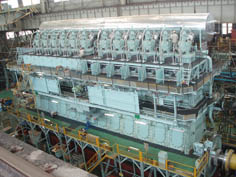Turbocharger Cut-Off Running Mode for Electronically Controlled Marine Diesel Engines Launched
Apr. 21, 2009

|
Tokyo, April 21, 2009 – Kawasaki Heavy Industries, Ltd. announced today that it has successfully commercialized the world’s first turbocharger cut-off running mode for an electronically controlled marine diesel engine that reduces fuel oil consumption at part load. This technological breakthrough goes a long way toward solving the problems of mounting CO2 and other greenhouse gas emissions as well as fluctuating oil prices. The running mode is designed for a main engine fitted with three or more turbochargers. When the engine is operating at part load, one of the turbochargers is intentionally cut off to increase scavenging air pressure, compression air pressure, and maximum combustion pressure. This pressure increase boosts thermal efficiency. The remarkable new running mode pared down fuel consumption up to 4% during onshore testing performed with a Kawasaki-MAN B&W 12K98ME engine in late 2008. The running mode was first installed on Kawasaki Kisen’s 8,000 TEU container ship which went into service in March 2009. Usually, whenever a main engines’ combustion performance is enhanced, there is a surge in flame temperatures that triggers more NOx emissions. At the same time output from the waste heat recovery system declines due to reduced exhaust gas energy. This new running mode cuts fuel consumption while maintaining steady exhaust gas temperatures and keeping NOx emissions within regulatory limits. Optimum exhaust valve timing, fuel injection timing, and adjustment of the exhaust gas bypass rate according to load all work to keep NOx emissions down. Turbocharger cut-off plates have to be manually installed in the gas lines, but the electronically controlled system’s operator-friendly design makes it possible to operate the mode and make adjustments to the main engine with the touch of a finger. All the engine operator has to do is simply touch the “T/C Cut” switch on the engine control panel. Kawasaki is working to develop innovative ways that will optimize engine performance and vessel energy systems by maximizing the variable control mechanisms on electronically controlled marine diesel engines. |
|





